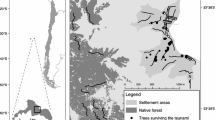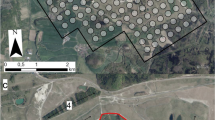Abstract
The reed belt around Lake Neusiedl is one of the largest connected reed areas in Europe, and thus bears crucial importance for the conservation of species depending on this habitat. In the last decades, a decline of reed harvesting has led to the formation of very old reed areas. Here we investigate how age and structure of degraded reed affect breeding bird species. We related extensive bird counts of eight species at 111 points to habitat measurements and reed age. Species differed in their preferred age class; for example, Great Reed Warblers Acrocephalus arundinaceus are found mainly in up to 4-year-old reed stands, while Little Crakes Zapornia parva prefer to settle in more than 14-year-old vegetation. We expected some species to be more common in older age classes, but our results demonstrate that large parts of the reed stands become too degraded even for these “old reed” specialists. Several bird species showed an inverse u-shaped relationship to habitat characteristics associated with reed die-back, e.g. accumulation of broken reed stems, occurrence of matted reed, low vegetation height or open water areas. At present, harvested areas are small and burning of reed is prohibited, and in the future, we expect more reed die-back with declining bird numbers. Missing ice cover in wintertime because of climate warming prevents sustainable cutting of these very old reed stands. We thus recommend a cautious introduction of fire management as a measure to secure this unique bird habitat.
Zusammenfassung
Schilfsterben und Schutz kleiner Schilfvögel am Neusiedler See, Österreich
Der Schilfgürtel des Neusiedler Sees ist eines der größten zusammenhängenden Schilfgebiete Europas und daher von entscheidender Bedeutung für die Erhaltung von Arten, die auf diesen Lebensraum angewiesen sind. In den letzten Jahrzehnten führte ein Rückgang der Schilfernte zur Bildung von sehr alten Schilfbeständen. Hier untersuchen wir, wie sich Alter und Struktur des degradierten Schilfs auf Brutvogelarten auswirken. Dazu haben wir Vogelzählungen von acht Arten an 111 Punkten mit Habitatmessungen und Schilfalter in Beziehung gesetzt. Die Arten unterschieden sich in ihrer bevorzugten Altersklasse; so ist der Drosselrohrsänger Acrocephalus arundinaceus hauptsächlich in bis zu vier Jahre alten Schilfbeständen anzutreffen, während das Kleine Sumpfhuhn Zapornia parva bevorzugt in mehr als 14 Jahre alter Vegetation brütet. Wir erwarteten, dass einige Arten in den ältesten Altersklassen häufiger vorkommen würden, doch große Teile der Schilfbestände waren selbst für diese "Altschilf"-Spezialisten zu degradiert. Habitatmerkmale, die mit dem Absterben des Schilfs zusammenhängen, z. B. Anhäufung gebrochener Schilfstängel, Auftreten von verfilztem Schilf, geringe Vegetationshöhe oder offene Wasserflächen, werden von einigen Arten bei mittleren Werten bevorzugt. Extreme Werte wirken sich aber immer negativ auf das Vorkommen aus. Gegenwärtig sind die abgeernteten Flächen klein und das Abbrennen von Schilf ist verboten, und für die Zukunft ist mit einem stärkeren Absterben des Schilfs und einem Rückgang der Vogelzahlen zu rechnen. Die fehlende Eisdecke im Winter aufgrund der Klimaerwärmung verhindert ein nachhaltiges Abschneiden dieser sehr alten Schilfbestände. Wir empfehlen daher eine vorsichtige Einführung des Feuermanagements als Maßnahme zur Sicherung dieses einzigartigen Vogellebensraums.




Similar content being viewed by others
Data availability
All data used in GLMs and ordinal regression models are provided as supplementary material (S5).
References
Angelini P, Rubini A, Gigante D, Reale L, Pagiotti R, Venanzoni R (2012) The endophytic fungal communities associated with the leaves and roots of the common reed (Phragmites australis) in Lake Trasimeno (Perugia, Italy) in declining and healthy stands. Fungal Ecol 5:683–693. https://doi.org/10.1016/j.funeco.2012.03.001
Antoniazza M, Clerc C, Le Nédic C, Sattler T, Lavanchy G (2018) Long-term effects of rotational wetland mowing on breeding birds: evidence from a 30-year experiment. Biodivers Conserv 27:749–763. https://doi.org/10.1007/s10531-017-1462-1
Armstrong J, Armstrong W (2001) An overview of the effects of phytotoxins on Phragmites australis in relation to die-back. Aquat Bot 69:251–268. https://doi.org/10.1016/S0304-3770(01)00142-5
Armstrong J, Armstrong W, Van Der Putten WH (1996) Phragmites die-back: bud and root death, blockages within the aeration and vascular systems and the possible role of phytotoxins. New Phytol 133:399–414. https://doi.org/10.1111/j.1469-8137.1996.tb01907.x
Bart D, Hartman JM (2000) Environmental determinants of Phragmites australis expansion in a New Jersey salt marsh: an experimental approach. Oikos 89:59–69
Barton K (2019) MuMIn: multi-model inference. R package version 1.4.6
Brix H (1999) The European Research Project on reed die-back and progression (EUREED). Limnologica 29:5–10. https://doi.org/10.1016/S0075-9511(99)80033-4
Calcagno V (2020) Glmulti: an R package for easy automated model selection. R package version 1.4.6
Clevering OA (1999) The effects of litter on growth and plasticity of Phragmites australis clones originating from infertile, fertile or eutrophicated habitats. Aquat Bot 64:35–50. https://doi.org/10.1016/S0304-3770(99)00009-1
Csaplovics E (2019) Der Schilfgürtel des Neusiedler Sees. Österr Wasser-Abfallwirtsch 71:494–507. https://doi.org/10.1007/s00506-019-00622-2
Csaplovics E, Schmidt J (2011) Schilfkartierung Neusiedler See, Ausdehnung und Struktur der Schilfbestände des Neusiedler Sees - Projektmanagement, Erfassung und Kartierung des österreichischen Anteils durch Luftbildklassifikation. Technische Universität Wien - Institut für Photogrammetrie und Fernerkundung, Dresden
Csaplovics E, Bácsatyai L, Márkus I, Sindhuber A (1997) Digitale Geländemodelle des Neusiedler Seebeckens. Wissenschaftliche Arbeiten aus dem Burgenland, Burgenländisches Landesmuseum, Eisenstadt Bgld 97, Wissenschaftliche Arbeiten aus dem Burgenland, Burgenländisches Landesmuseum, Eisenstadt Bgld 97. Burgenländisches Landesmuseum, Eisenstadt
Davidson NC (2014) How much wetland has the world lost? Long-term and recent trends in global wetland area. Mar Freshw Res 65:934–941. https://doi.org/10.1071/MF14173
Den Hartog C, Květ J, Sukopp H (1989) Reed. A common species in decline. Aquat Bot 35:1–4. https://doi.org/10.1016/0304-3770(89)90062-4
Dinka M, Szeglet P (1999) Carbohydrate and Nutrient Content in Rhizomes of Phragmites australis from Different Habitats of Lake Ferto/Neusiedlersee. Limnologica 29:S47–S55
Dinka M, Ágoston-Szabó E, Szeglet P (2010) Comparison between biomass and C, N, P, S contents of vigorous and die-back reed stands of Lake Ferto/Neusiedler See. Biologia (bratisl) 65:237–247. https://doi.org/10.2478/s11756-010-0006-x
Dvorak M, Nemeth E, Tebbich S, Rössler M, Busse K (1997) Verbreitung, Bestand und Habitatwahl schilfbewohnender Vogelarten in der Naturzone des Nationalparks Neusiedler See - Seewinkel. [Distribution, status and habitat selection of reed dwelling birds in the Nature Zone of the Neusiedler See National Park. BFB-Bericht 86. Biologische Station Illmitz, Illmitz Austria
Dvorak M, Grüll A, Laber J, Ranner A (2020) Beiträge zur Vogelwelt des Neusiedler See – Gebietes. BirdLife Austria, Vienna
European Space Agency (2018) Sentinel 2. Sentinel Online. https://sentinel.esa.int/web/sentinel/missions/sentinel-2. Accessed 27 Feb 21
Gigante D, Angiolini C, Landucci F, Maneli F, Nisi B, Vaselli O, Venanzoni R, Lastrucci L (2014) New occurrence of reed bed decline in southern Europe: do permanent flooding and chemical parameters play a role? Comptes Rendus Biol 337:487–498. https://doi.org/10.1016/j.crvi.2014.05.005
Graveland J (1999) Effects of reed cutting on density and breeding success of Reed Warbler Acrocephalus scirpacaeus and Sedge Warbler A. schoenobaenus. J Avian Biol 30:469–482. https://doi.org/10.2307/3677019
Güsewell S (2003) Management of Phragmites australis in Swiss fen meadows by mowing in early summer. Wetl Ecol Manag 11:433–445. https://doi.org/10.1023/B:WETL.0000007197.85070.58
Hazelton ELG, Modzer TJ, Burdick DM, Kettenring KM, Whigham DF (2014) Phragmites australis management in the United States: 40 years of methods and outcomes. AoB Plants 6:plu001. https://doi.org/10.1093/aobpla/plu001
Hillcoat B (1994) Emberiza schoeniclus. In: Cramp S, Perrins CM (eds) Handbook of the birds of Europe, the Middle East and North Africa, vol 9. Oxford University Press, Oxford, pp 276–294
Lastrucci L, Cerri M, Coppi A, Ferranti F, Ferri V, Foggi B, Lazzaro L, Reale L, Venanzoni R, Viciani D, Gigante D (2017) Understanding common reed die-back: a phytocoenotic approach to explore the decline of palustrine ecosystems. Plant Sociol 54:15–28. https://doi.org/10.7338/pls2017542S1/02
Leisler B (1981) Die ökologische Einnischung der mitteleuropäischen Rohrsänger (The ecological niches of Central European reed warblers). Vogelwarte 31:45–74
Leisler B (1991) Acrocephalus melanopogon (Temminck 1832)- Mariskensänger. In: Glutz von Blotzheim UN (eds) Handbuch der Vögel Mitteleuropas. AULA-Verlag, Wiesbaden, p 51–60
Leisler B, Schulze-Hagen K (2011) The Reed Warblers: diversity in a uniform bird family, 1st edn. Zeist, KNNV PUB
Nemeth E, Dvorak M, Busse K, Rössler M (2001) Estimating distribution and density of reed birds by aerial infrared photography. In: Field R, Warren RJ, Okarma H, Siewert PR (eds) Wildlife, land, and people: priorities for the 21st century. The Wildlife Society, Bethseda, pp 397–399
Ostendorp W (1999) Susceptibility of lakeside Phragmites reeds to environmental stresses: examples from Lake Constance-Untersee (SW-Germany). Limnologica 29:21–27. https://doi.org/10.1016/S0075-9511(99)80035-8
Poulin B, Lefebvre G (2002) Effect of winter cutting on the passerine breeding assemblage in French Mediterranean reedbeds. Biodivers Conserv 11:1567–1581. https://doi.org/10.1023/A:1016866116220
R Core Team (2019) R: a language and environment for statistical computing. R Foundation for Statistical Computing, Vienna, Austria. https://www.R-project.org/
Rea N (1996) Water levels and Phragmites: decline from lack of regeneration or dieback from shoot death. Folia Geobot 31:85–90
Rücker A, Grosser S, Melzer A (1999) History and causes of reed decline at Lake Ammersee (Germany). Limnologica 29:11–20. https://doi.org/10.1016/s0075-9511(99)80034-6
Schmidt MH, Lefebvre G, Poulin B, Tscharntke T (2005) Reed cutting affects arthropod communities, potentially reducing food for passerine birds. Biol Conserv 121:157–166. https://doi.org/10.1016/j.biocon.2004.03.032
Soja G, Züger J, Knoflacher M, Kinner P, Soja AM (2013) Climate impacts on water balance of a shallow steppe lake in Eastern Austria (Lake Neusiedl). J Hydrol 480:115–124. https://doi.org/10.1016/j.jhydrol.2012.12.013
Šťastný V, Riegert J (2021) Habitat use of breeding birds in Central European reed beds. Wetl Ecol Manag 29:81–91. https://doi.org/10.1007/s11273-020-09768-3
Tóth VR (2016) Reed stands during different water level periods: physico-chemical properties of the sediment and growth of Phragmites australis of Lake Balaton. Hydrobiologia 778:193–207. https://doi.org/10.1007/s10750-016-2684-z
Tscharntke T (1999) Insects on common reed (Phragmites australis): community structure and the impact of herbivory on shoot growth. Aquat Bot 64:399–410. https://doi.org/10.1016/S0304-3770(99)00066-2
Vadász C, Német E, Biró C, Csörgö T (2008) The effect of reed cutting on the abundance and diversity of breeding passerines. Acta Zool Acad Sci Hung 54(Suppl):177–188
Valkama E, Lyytinen S, Koricheva J (2008) The impact of reed management on wildlife: a meta-analytical review of European studies. Biol Conserv 141:364–374. https://doi.org/10.1016/j.biocon.2007.11.006
van der Putten WH (1997) Die-back of Phragmites australis in European wetlands: an overview of the European Research Programme on Reed Die-Back and Progression (1993–1994). Aquat Bot 59:263–275. https://doi.org/10.1016/s0304-3770(97)00060-0
Weisner SEB (1996) Effects of an organic sediment on performance of young Phragmites australis clones at different water depth treatments. Hydrobiologia 330:189–194. https://doi.org/10.1007/BF00024207
Zhang D (2017) A coefficient of determination for generalized linear models. Am Stat 71:310–316. https://doi.org/10.1080/00031305.2016.1256839
Acknowledgements
We thank Arno Cimadom, Niki Filek, Johannes Frühauf, Christina Nagl, Benny Knees, Christoph Roland and Péter Villányi for counting birds. Paul Nemeth assisted in habitat measurements. The head of the Biological Station Illmitz, Thomas Zechmeister, and staff members Richard Haider und Rudi Schalli contributed logistic support. We are grateful that Viktor Tóth discussed reed die-back and possible measures against it, and that Bernd Leisler supplied information about habitat selection of the Moustached Warbler. We thank Bernhard Kohler and Marlon Schwienbacher (WWF Austria) for technical and logistical coordination of the project and Benjamin Seaman for improving the language of the manuscript.
Funding
Fieldwork and analyses were funded by the Rural Development Program 2014–2020 of the European Commission and the Federal Government of Burgenland. (Grant number: Le 14-20).
Author information
Authors and Affiliations
Contributions
EN wrote first draft of manuscript, made statistical analyses, took part in planning and conducting fieldwork, MD took part in writing of the manuscript and planning and organizing of the study.
Corresponding author
Ethics declarations
Conflict of interest
There exists no conflicts of interests/no competing interests.
Consent to participate
All authors gave consent to participate.
Additional information
Communicated by T. Gottschalk.
Publisher's Note
Springer Nature remains neutral with regard to jurisdictional claims in published maps and institutional affiliations.
Supplementary Information
Below is the link to the electronic supplementary material.
Rights and permissions
About this article
Cite this article
Nemeth, E., Dvorak, M. Reed die-back and conservation of small reed birds at Lake Neusiedl, Austria. J Ornithol 163, 683–693 (2022). https://doi.org/10.1007/s10336-022-01961-w
Received:
Revised:
Accepted:
Published:
Issue Date:
DOI: https://doi.org/10.1007/s10336-022-01961-w




